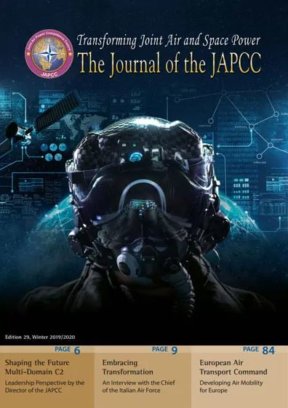Introduction
This article will discuss the Air Command and Control (Air C2) organisation in NATO with regard to Operation Unified Protector (OUP) in 2011. It will focus on recognizing the challenges from the Air Campaign, which ended 31 October 2011. Specifically, the takeover by NATO of an ongoing operation and the challenges therein will be discussed.
The article will specifically be orientated towards the Joint Force Air Component (JFAC) and to understand its limitations and possibilities. In the case of OUP, a Combined Force Air Component (CFAC) was established, and the article will refer to this further on. Additionally, OUP will be investigated and summarized to understand how the use of Air Power affected the nature of the conflict and whether NATO conducted a sufficiently structured Air Campaign in order to deal with the rapidly emerging air situation of the Libyan conflict.
Operation Unified Protector
The campaign was initiated by UNSCR 1970 (United Nations Security Council, S/RES/1970 (2011)) and was followed by a NATO-led operation in the Mediterranean commencing on 31 March 2011. OUP brought forth a coalition of NATO allies and partners, which initiated a no-fly zone and used Air Capabilities to enforce the protection of civilians from attack or the threat of attack.
Initially named Operation Odyssey Dawn (OOD) under a US flag, the shift from that operation to the NATO OUP was not without challenges. Operation HARMATTAN, Operation ELLAMY, Operation MOBILE and OOD were all separate official operations by individual nations. OOD is in this context used as a collective name for the coalition operation.1
NATO Organization
‘The other side of knowing the enemy is knowing oneself.’2
To investigate the NATO organization that dealt with OUP, it would be beneficial to look into the structure of the combat staff, meaning the CFAC and the Combined Air Operations Centre (CAOC).
The command structure of OUP initially consisted of Supreme Headquarters Allied Powers Europe (SHAPE), then the Combined Joint Task Force (CJTF) at Naples subordinate to SHAPE and further subordinate was the Air Command Headquarters Southern Europe in Izmir, Turkey (AC Izmir), who managed the Air Campaign. Effectively, CAOC Poggio Renatico, Italy (CAOC PR), conducted the execution of the Air Operations, subordinate to AC Izmir. Parts of AC Izmir moved to CAOC PR and a CFAC was established with contributions from various nations. The CFAC rapidly assumed control and executed more than 120 sorties daily. The reason for using a CFAC was in relation to the fact that more than one nation from NATO participated in the campaign. Furthermore, the CFAC was planning and conducting Air Operations without a joint aspect. Command and Control (C2) in NATO at that time, was doctrinally clear and precise in respect to establishing an organization (JFAC or CFAC) to manage an operation.
It was expected that NATO would easily transition into the lead of an already ongoing operation and promptly employ assigned forces. The CFAC was undeniably strengthened by both the Izmir staff, who rapidly deployed to CAOC PR, as well as augmentees from contributing nations.
Nevertheless, the start of the NATO management of the air situation seemed to waver. A challenge existed for the air planners to conduct prudent and effective planning during the initial days of OUP.3 This was primarily due to a lack of appreciation of the varied communications technologies of the participating NATO members and difficulties in integrating their different planning systems. Whether the challenge was nationally grounded in the United States (US) planning system or the planners understanding of the requirements, the situation demonstrated an interoperability problem between some NATO forces and an experience issue with the planners at hand. Additionally, the differences between the US and NATO way of planning had been illustrated clearly at the change-of-command from OOD to OUP when comparing the arrangements from the US perspective. More players would add complexity for the JFC and JFAC in taking over the mission. The evidence of the command change, as well as the organizational move to CAOC PR and lack of supporting and compatible systems at the beginning of OUP showcased the difficulty in inheriting an ongoing operation.4
Personnel
Colonel Daniel Baltrusaitis showed that the organizational construct of the CFAC needed to adapt to an agile situation.5 Additionally, Baltrusaitis suggested that the size of the personnel cadre in CAOC PR was lower at the beginning of OUP, compared to OOD. Participating nations were requested by NATO to augment the CAOC and CFAC with experts and staff officers. Too few augmentees were requested and their initial attachment to the organization was limited to one month’s duration. One can argue that the preferred time frame for an augmentee would exceed one month to build the basic knowledge of the position, to understand the typical battle rhythm and to eventually have the capacity to adapt to and overcome changing situations with professional efficiency. NATO took over the operation in late March with the bulk of augmentees arriving in April and May. After longer tour lengths of 3 months were approved, July and August saw a sudden reduction in augmentees, as they were not readily replenished by the nations. There was no evidence to suggest a reason for the reduction in augmentees, although it could have been based on either a deficiency of personnel with the required skills and/or the lack of motivation for individuals to sign up for a mission during the summer season. Additionally, some nations did not have sufficient personnel attached to the CFAC or the CAOC in permanent positions, leading to difficulty in sustaining a high level of knowledge and understanding of the headquarters battle rhythm when commencing rapid augmentation.6
Air Power Challenges in OUP
While the time frame between the OOD and OUP was not protracted, and although the organization in CAOC PR and the CFAC had reacted beforehand and conducted prudent planning, the Community of Shared Interest (all OOD players) had already conducted several flying missions and therefore prearranged the airspace battlefield. Despite this, the battle plan following the OUP takeover was initially ineffective, and the support for moving part of the JFAC into the CAOC was lacking.7 Why was the battle plan not effective?
Battle Plan
One of the limitations of the plan may have originated with the UNSCR 1973. The resolution called for the end of hostilities and urged the nations (OOD players) to protect civilians and civilian-populated areas. A potentially relevant aspect is that the political determination and strategy of key NATO allies changed in April 20118 to a more offensive focus to eliminate the leader of Libya, Muammar Gaddafi. When the political objective was altered so deliberately, the perception of the strategic leaders in NATO could be assumed to shift as well. The challenge for the Air Planners at CAOC PR would be to implement the CFAC Commander’s interpretation of the CJTF Commander’s intent. Hence, improving the effectiveness of the battle plan.
Dr. Meilinger found that the most important task of the Air Commander (in this case the CFAC Commander) is to select the appropriate strategy for specific conditions.9 While (communication) technology plays an essential role in revealing masses of information to the Air Commander, this does not seem to be the driving factor for the difficulties of his battle plan, since the directive should be clear to everybody. According to Dr. Meilinger, a doctrine contributes guidance for action, which facilitates and focuses the Air Commander’s (and his/her staff’s) work process. The dilemma reveals itself when a doctrine does not operationally fit the strategic changes. This dilemma became evident in OUP when the objective was switched during the campaign.
Agility
Finally, there was a significant lack of support for moving/deploying the organization. To be able to move rapidly and with flexibility, the organization and the leaders would have to be agile. NATO’s glossary of terms and definitions, AAP-06, does not contain the word ‘agile’. In the Oxford English Dictionary, the adjective’s meaning is twofold: ‘able to move quickly and easily’, and ‘able to think and understand quickly’.10 Studying NATO documents from the time before OUP reveals the following.
NATO was in the post 9/11 era and forming a perspective about the security environment in which NATO would act and react.11 Based on those security perspectives at the time in 2006, NATO formed guidelines for the nations and the Alliance Capability Requirements. One may argue, that the period from 2006 until the beginning of OUP would be ample time for the nations and NATO to form a training environment and an educational basis for leaders to be able to facilitate the preparedness toward an agile organization. Procurements and military installations typically take more time to be completed. It is therefore more relevant to focus on what may have changed over those five years. The 2010 Strategic Concept is not perceived as relevant in this context, as the strategic focus is usually not adopted by the Alliance immediately after the release of the Concept.
Requirements normally take time to implement in the Alliance. Those requirements on the military level consisted of agility and flexibility in both conceptual and organizational aspects. As NATO states: ‘… put a premium on improvements in meeting the following capability requirements: the ability to adapt force postures and military responses rapidly and effectively to unforeseen circumstances. This requires, among other things, an effective capability to analyze the environment and anticipate potential requirements, a high level of readiness for our forces, and the necessary flexibility to respond to any sudden shifts in requirements.’12
This statement highlights agility as a key requirement. Emphasizing the principle of an agile organization means being prepared and in a position of high readiness is considered vital. The preparation could be completed by a well-trained expeditious group of people ready to assume any tactical Air C2 planning and execution. Reviewing the OUP experience, there was an indication that the CFAC organization was not ready to execute its mission. National augmentees were not sufficiently educated in their specialities. Some nations committed insufficient funding of their military to meet NATO requirements.13 Funding of NATO (or lack of it) will drive the size and the structure of the organization and will have a significant follow on effect to the training and the readiness of its personnel.
Future Outlook
When focused on NATO’s current level of ambition and picking up the trends of the development, one might find the future promising. The JAPCC conference keynote speakers have more than once declared agility of transition, nations’ buy-in of technology and personnel as well as flexible and affordable NATO solutions to be the way forward.14
Before the handover/takeover from the OOD to the OUP, there was no template to follow. From the agility perspective, the Air C2 community is preparing to strengthen its experience in standing up distributed C2. The transition phase from Baseline Activities and Current Operations (BACO) through crisis up to Maximum Level of effort (MLE) will be effective and swift when a formalized training plan is in place for Air C2 (SME) capacity and responsiveness. It is, again, up to the nations to fulfil the ambition.
Conclusions
There were organizational difficulties that made it difficult to execute the Air Operations, although the preceding structure of the organization (OOD) had taken into account a possibility to deploy and rapidly commence operations.
As there were no unplanned fatalities, the mission can only be deemed successful. The lack of the right personnel at the right time and the difficulties of moving a headquarters into another headquarters might always be a limitation. However, the agility requirements need consideration.
‘The very nature of contingency operations means that no C2 construct will be fit for purpose in every instance, and regular exercising with a varying number of international partners ensures flexibility of mindset.’15 Retrospectively, OUP pushed NATO’s conceptual perspective to find a more agile posture. Whether or not that will align perfectly with the current threat of 2019 and beyond, is another question.












